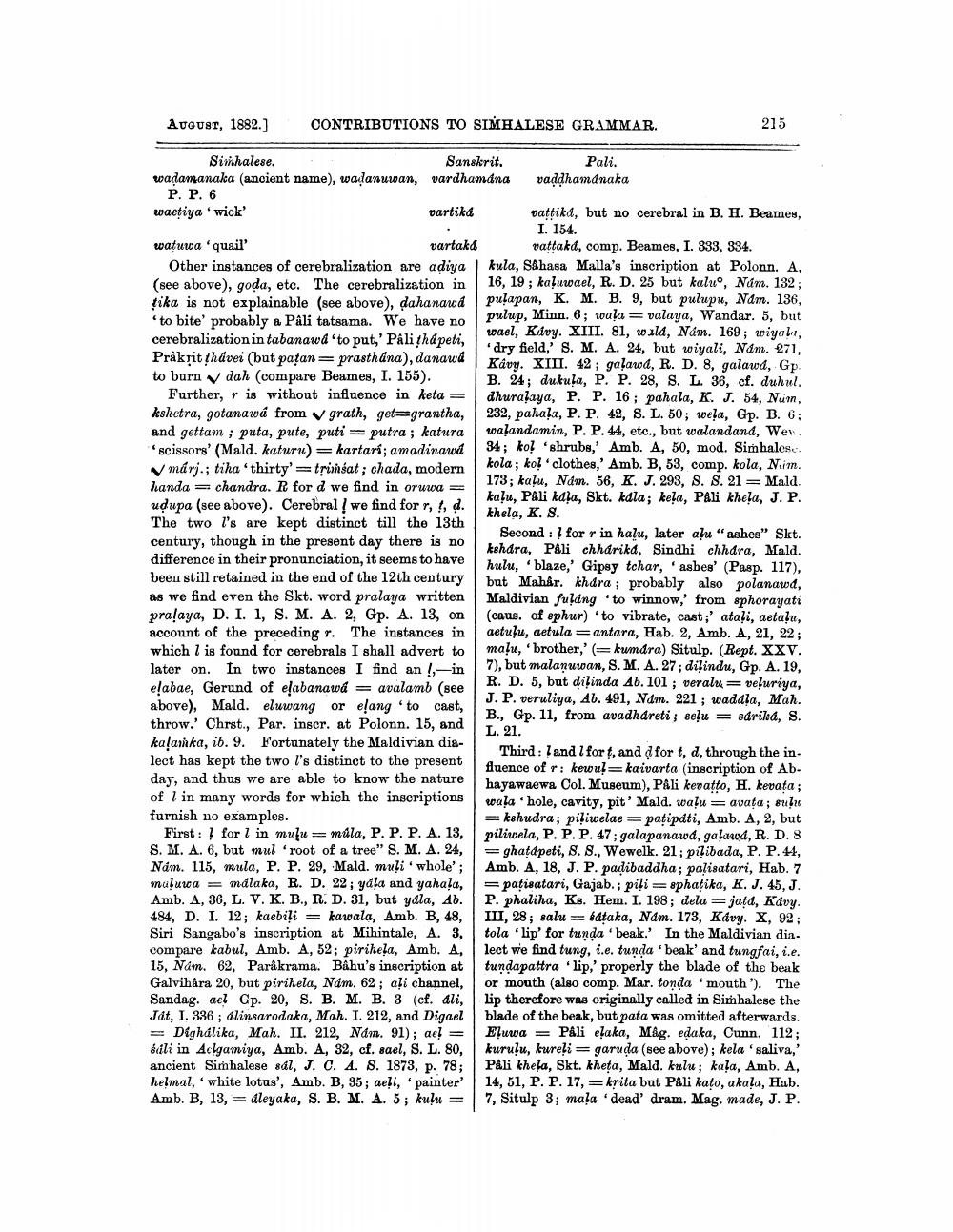________________
August, 1882.]
CONTRIBUTIONS TO SIMHALESE GRAMMAR.
215
Sinhalese.
Sanskrit.
Pali. wadamanaka (ancient name), wadanuwan, vardhamana vaddhamdnaka
P. P. 6 waetiya 'wick
vartika vattikd, but no cerebral in B. H. Beames,
I. 154. watuwa'quail'
vartakų vattakd, comp. Beames, I. 333, 334. Other instances of cerebralization are adiya kula, Såhasa Malla's inscription at Polonn. A, (see above), goda, etc. The cerebralization in 16, 19; kaluwael, R. D. 25 but kalu, Nám. 132; tika is not explainable (see above), dahanawa pulapan, K. M. B. 9, but pulupu, Nam. 136, to bite' probably a Páli tatsama. We have no
pulup, Minn. 6; wala = valaya, Wandar. 5, but
wael, Kavy. XIII. 81, wild, Nám. 169; wiyalı, cerebralization in tabanawa 'to put,' Palithápeti,
dry field,' s. M. A. 24, but wiyali, Nam. 271, Praksit hávei (but patan= prasthana), danaud
Kavy. XIII. 42; galawd, R. D. 8, galawd, Gp to burndah (compare Beames, I. 155).
B. 24; dukula, P. P. 28, S. L. 36, cf. duhul. Further, r is without influence in keta = dhuralaya, P. P. 16 : pahala, K. J. 54, Num, kshetra, gotanawá from v grath, get=grantha, 232, pahala, P. P. 42, S. L. 50; wela, Gp. B. 6: and gettam ; puta, pute, puti = putra; katura
walandamin, P. P. 44, etc., but walandand, Wew. scissors' (Mald. katuru) = kartari; amadinawd
34; kol shrubs,' Amb. A, 50, mod. Simhalese V máry.; tiha thirty'=trinnsat; chada, modern kola ; kolclothes,' Amb. B, 53, comp. kola, Nim. handa = chandra. R for d we find in oruwa =
173; kalu, Nám. 56, K. J. 293, S. 8. 21=Mald.
kalu, PAli kala, Skt. kala; kela, Pali khela, J. P. udupa (see above). Cerebral ! we find for r, !, d.
khela, K. S. The two l's are kept distinct till the 13th
Second : ? for r in halu, later alu "ashes" Skt. century, though in the present day there is no
kshdra, Pali chharikd, Sindhi chhdra, Mald. difference in their pronunciation, it seems to have
hulu, blaze,' Gipsy tchar, 'ashes' (Pasp. 117), been still retained in the end of the 12th century but Mahâr.khdra ; probably also polanawd, as we find even the Skt. word pralaya written Maldivian fulang 'to winnow,' from sphorayati pralaya, D. I. 1, S. M. A. 2, Gp. A. 13, on (caus. of ephur) 'to vibrate, cast;' atali, aetaļu, account of the preceding r. The instances in aetulu, aetula=antara, Hab. 2, Amb. A, 21, 22; which 1 is found for cerebrals I shall advert to malu, brother,'(=kumdra) Situlp. (Rept. XXV. later on. In two instances I find an !,-in
7), but malanuwan, S.M. A. 27; dilindu, Gp. A. 19, elabae, Gerund of elabanawa = avalamb (see
R. D. 5, but diļinda Ab. 101 ; veralu = veluriya,
J. P. veruliya, Ab. 491, Nám. 221; waddla, Mah. above), Mald. eluwang or elang 'to cast,
B., Gp. 11, from avadhdreti; selu = sdrikd, S. throw.' Chrst., Par. inscr. at Polonn. 15, and
L. 21. kalanka, ib. 9. Fortunately the Maldivian dia
Third : and I fort, and à for t, d, through the in. lect has kept the two l's distinct to the present
fluence of r: kewul=kaivarta (inscription of Ab. day, and thus we are able to know the nature
hayawaewa Col. Museum), PAli kevatto, H. kevata; of l in many words for which the inscriptions
wala *hole, cavity, pît' Mald. walu= avata; subu furnish no examples.
= kshudra; pitiwelae = patipdti, Amb. A, 2, but First: I for l in mulu = müla, P. P. P. A. 13, piliwela, P. P. P. 47; galapanawd, galawd, R. D. 8 S. M. A. 6, but mul 'root of a tree" S. M. A. 24, = ghatdpeti, S. S., Wewelk. 21; pilibada, P. P. 44, Nám. 115, mula, P. P. 29, Mald. muti' whole'; Amb. A, 18, J. P. padibaddha; palisatari, Hab. 7 maluwa = mdlaka, R. D. 22; yala and yahala, = patisatari, Gajab.; pili =sphatika, K. J. 45, J. Amb. A, 36, L. V. K. B., R. D. 31, but yala, Ab. P. phaliha, Ks. Hem. I. 198; dela = jatd, Kavy. 484, D. I. 12; kaebili = kawala, Amb. B, 48, III, 28; salu = bataka, Nám. 173, Kavy. X, 92: Siri Sangabo's inscription at Mihintale, A. 3, tola 'lip' for tunda beak.' In the Maldivian din. compare kabul, Amb. A, 52; pirihela, Amb. A, lect we find tung, i.e. tunda 'beak' and tungfai, i.e. 15, Nám. 62, Paråkrama. Bahu's inscription at tundapattra "lip,' properly the blade of the beak Galvihåra 20, but pirihela, Nám. 62; ali channel, or mouth (also comp. Mar. tonda 'mouth'). The Sandag. ael Gp. 20, S. B. M. B. 3 (cf. ali, lip therefore was originally called in Sinhalese the Ját, I. 336, alinsarodaka, Mah. I. 212, and Digael blade of the beak, but pata was omitted afterwards. = Dighalika, Mah. II. 212, Nám. 91); ae! = Eļuwa = PAli elaka, Måg. edaka, Cunn. 112; édli in Aclgamiya, Amb. A, 32, cf. sael, S. L. 80, kurulu, kureli=garuda (see above); kela 'saliva,' ancient Sinhalese sál, J. C. 4. S. 1873, p. 78; Pali khela, Skt. kheta, Mald. kulu; kala, Amb. A, helmal,' white lotus', Amb. B, 35; aeli, painter' 14, 51, P. P. 17,=krita but PAli kato, akala, Hab. Amb. B, 13, = aleyaka, S. B. M. A. 5; kulu = 7, Situlp 3; mala 'dead' dram. Mag. made, J. P.




